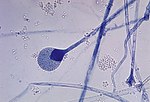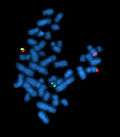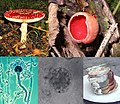Meiosis (redirect from Haploid stage)
ultimately result in four cells, each with only one copy of each chromosome (haploid). Additionally, prior to the division, genetic material from the paternal...
64 KB (7,478 words) - 23:27, 22 August 2024
Doubled haploidy (redirect from Doubled haploid)
A doubled haploid (DH) is a genotype formed when haploid cells undergo chromosome doubling. Artificial production of doubled haploids is important in...
18 KB (2,612 words) - 11:55, 2 November 2023
involve alternating haploid (n) and diploid (2n) stages, i.e., a change of ploidy is involved. To return from a diploid stage to a haploid stage, meiosis must...
24 KB (2,968 words) - 11:57, 28 August 2024
of reproduction that involves a complex life cycle in which a gamete (haploid reproductive cells, such as a sperm or egg cell) with a single set of chromosomes...
39 KB (4,860 words) - 14:45, 26 August 2024
plasmodium, which develops from the amoebula. In plants, spores are usually haploid and unicellular and are produced by meiosis in the sporangium of a diploid...
24 KB (2,057 words) - 09:45, 13 August 2024
ultimately from Ancient Greek γάμος (gámos) 'marriage') is a haploid cell that fuses with another haploid cell during fertilization in organisms that reproduce...
12 KB (1,360 words) - 17:27, 5 August 2024
exist as either haploid cells, which contain a single set of chromosomes, or diploid cells, which contain two sets of chromosomes. Haploid yeast cells come...
48 KB (5,879 words) - 09:06, 10 August 2024
multicellular: the haploid sexual phase – the gametophyte – alternates with a diploid asexual phase – the sporophyte. A mature sporophyte produces haploid spores...
40 KB (4,576 words) - 05:27, 4 May 2024
in turn produces haploid spores. The diploid stage is relatively small and short-lived compared to the haploid stage, i.e. haploid dominance. The advantage...
31 KB (3,454 words) - 04:56, 23 August 2024
Karyogamy (section Importance in haploid organisms)
fusing together two haploid eukaryotic cells, and refers specifically to the fusion of the two nuclei. Before karyogamy, each haploid cell has one complete...
19 KB (2,272 words) - 05:23, 25 October 2023
genetic information of a new individual organism. The sexual fusion of haploid cells is called karyogamy, the result of which is the formation of a diploid...
9 KB (872 words) - 07:52, 28 June 2024
the life cycles of plants and algae. It is a haploid multicellular organism that develops from a haploid spore that has one set of chromosomes. The gametophyte...
26 KB (3,151 words) - 05:27, 23 August 2024
non-vascular plants is the gametophyte, which produces gametes and is haploid - with one set of chromosomes per cell.) Vascular plants have true roots...
24 KB (2,051 words) - 16:18, 22 August 2024
biological process by which diploid or haploid precursor cells undergo cell division and differentiation to form mature haploid gametes. Depending on the biological...
12 KB (1,396 words) - 05:33, 14 August 2024
sporangiophore and contains haploid nuclei and cytoplasm. Spores are formed in the sporangiophore by encasing each haploid nucleus and cytoplasm in a tough...
9 KB (901 words) - 13:05, 26 August 2024
a life cycle that involves sexual reproduction, alternating between a haploid phase, where only one copy of each chromosome is present in each cell,...
61 KB (6,087 words) - 12:28, 10 August 2024
produces a type of haploid spore by meiosis that is capable of undergoing repeated cell division to produce a multicellular haploid organism. In either...
66 KB (7,646 words) - 03:19, 29 August 2024
with 32 chromosomes divides to generate haploid cells called gametes with 16 chromosomes. The result is a haploid egg, with chromosomes having a new combination...
15 KB (2,091 words) - 03:26, 20 June 2024
Cytogenetics (redirect from Bands per haploid set)
chromosomes, the number of bands observable for all chromosomes (bands per haploid set, bph; "band level") increases from about 300 to 450 to as many as 800...
26 KB (2,921 words) - 15:28, 28 February 2024
Spermatogenesis is the process by which haploid spermatozoa develop from germ cells in the seminiferous tubules of the testicle. This process starts with...
33 KB (3,731 words) - 17:27, 15 August 2024
reproduction. During double fertilisation in angiosperms, the haploid male gamete combines with two haploid polar nuclei to form a triploid primary endosperm nucleus...
45 KB (5,218 words) - 23:47, 26 August 2024
into two haploid sperm cells by mitosis leading to the development of the pollen tube. At fertilization, one of the sperm cells unites its haploid nucleus...
50 KB (5,813 words) - 06:28, 20 August 2024
begin life as amoeba-like cells. These unicellular amoebae are commonly haploid and feed on small prey such as bacteria, yeast cells, and fungal spores...
54 KB (5,528 words) - 03:06, 16 July 2024
germinate and form a new haploid mycelium. Sexual reproduction in basidiomycetes is similar to that of the ascomycetes. Compatible haploid hyphae fuse to produce...
200 KB (19,172 words) - 18:21, 28 August 2024
Haplotype-relative-risk (redirect from Haploid-relative-risk)
The haplotype-relative-risk (HRR) method is a family-based method for determining gene allele association to a disease in the presence of actual genetic...
4 KB (663 words) - 04:55, 29 December 2023
the process of halving the chromosomal content of a cell, producing a haploid cell. Within the normal reproductive cycle, haploidisation is one of the...
2 KB (264 words) - 08:57, 6 January 2022
order to attract mates. Each haploid yeast cells express specific haploid genes; haploid α-cells express α-genes and haploid a-cells express a-genes. Each...
11 KB (1,220 words) - 13:00, 25 November 2023
forms, haploid and diploid, alternate, and these may or may not be isomorphic (having the same morphology). In haplobiontic species only the haploid generation...
26 KB (2,663 words) - 00:36, 27 August 2024
A haplotype (haploid genotype) is a group of alleles in an organism that are inherited together from a single parent. Many organisms contain genetic material...
16 KB (2,057 words) - 16:01, 28 August 2024
























